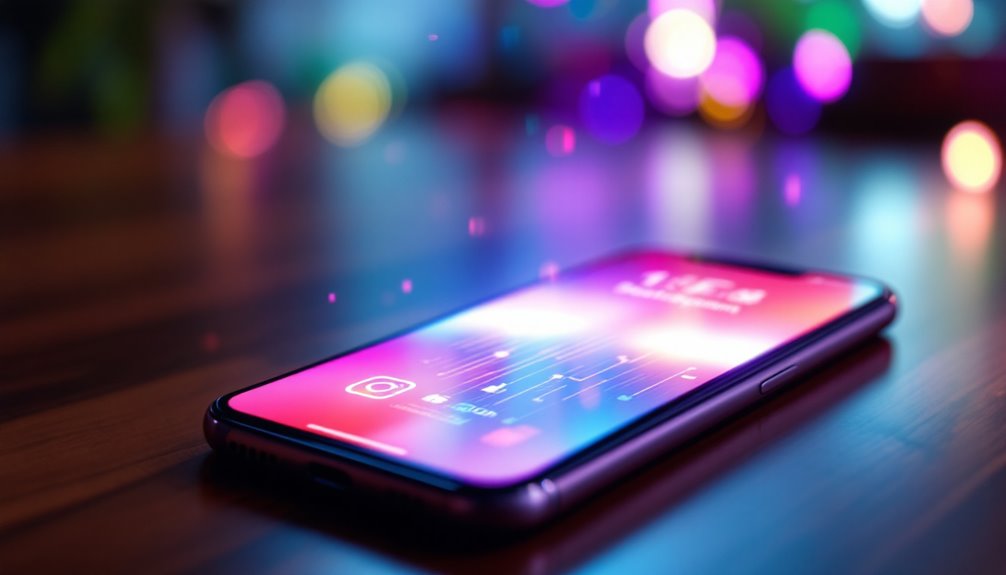
Many Instagram users don't realize that the platform itself doesn't notify you when someone unfollows you. This lack of notification leaves you relying on your own observations or third-party apps to track changes in your follower count. But before you rush to download an app, consider the security risks involved. You might wonder how this impacts your engagement and visibility on the platform. Curious about how to navigate these challenges effectively?
Key Takeaways
- Instagram doesn't provide a built-in feature to notify users of unfollowers.
- Manual tracking by checking the followers list can identify unfollowers.
- Third-party apps like Crowdfire can help track unfollowers without requiring passwords.
- Downloading Instagram data and analyzing it can reveal who unfollowed you.
- Regular audits of your follower list can offer insights into changes.
Understanding Instagram's Privacy Measures

When maneuvering Instagram's privacy measures, it's crucial to understand how these settings affect your online presence and interactions. Opting for a private account provides significant benefits by safeguarding your content from non-followers, ensuring only those you approve can access your posts and follower list. This requirement for follower approval not only enhances control over your audience but also fosters a more personalized interaction space. However, be mindful that private accounts inherently limit your reach and engagement, which could hinder innovation in audience growth strategies. Additionally, buying Instagram followers can offer a quick boost to visibility and legitimacy, helping to counteract some of the limitations of a private account. By disabling your online status, you can prevent others from viewing your personal activity, further maintaining your privacy on the platform.
The Role of Third-Party Apps and Tools
Maneuvering Instagram's privacy measures reveals the importance of controlling your audience, yet expanding engagement often requires external assistance.
Third-party apps offer innovative solutions but come with app security and data accuracy concerns. Consider:
- Security Risks: Many apps demand access to your Instagram credentials, posing significant security threats. Unauthorized app use could lead to account suspension.
- Data Inaccuracy: Free or low-quality apps often deliver incomplete or inaccurate data, misleading your engagement strategies.
- Functionality Variability: Reliable apps like Crowdfire provide unfollower tracking without requiring passwords, minimizing risk while offering detailed analytics. Some apps, such as Follow Meter, also track ghost followers, which can enhance your understanding of overall account interactions.
Assess an app's cost and reliability by checking reviews and ensuring they comply with Instagram's ever-changing API policies.
Choose wisely to balance innovation and security without compromising your account's integrity.
Exploring Manual Tracking Techniques
Although manual tracking techniques on Instagram can seem intimidating, they offer a precise way to monitor unfollowers without relying on third-party apps. Start by using manual follower tracking through username searches in your followers list. This method is time-consuming but guarantees checking unfollower accuracy by providing real-time insights. Remember, you need to recall specific usernames, which can be challenging.
Another approach involves downloading Instagram data legally. By exporting and comparing your follower lists in tools like Excel, you can systematically track changes, though it requires regular audits. Instagram does not provide a built-in feature to notify users of unfollowers, so relying on these methods ensures you remain within Instagram's terms of service.
Additionally, maintaining and updating a manual follower list can highlight unfollowers by cross-checking old and new lists. While labor-intensive, these methods provide accurate insights, fostering a deep understanding of your follower dynamics.
Implications on Post Visibility
Understanding the implications of unfollowing on Instagram is essential for managing post visibility. Unfollowing effects differ based on account privacy settings.
If your account is public, the unfollowed individual can still view your posts. However, for private accounts, only approved followers can see your content. This creates various visibility scenarios:
- Public Accounts: Unfollowing doesn't prevent access to your posts.
- Private Accounts: Only approved followers can view posts.
- Privacy Settings: Shifting from public to private restricts access.
Unfollowing removes their posts from your feed, but it doesn't affect their ability to see your profile if it's public. The action is purely one-sided and doesn't alter existing likes or comments. It's important to note that privacy settings dictate whether unfollowed users can continue to see your posts, depending on whether your account is public or private.
Consider privacy settings strategically to control visibility after unfollowing.

Exploring the dynamics of Instagram's algorithm in relation to user interactions reveals a complex ecosystem where engagement plays a pivotal role. Follower engagement directly influences your content's reach, as likes, comments, and shares determine visibility. Instagram updates follower counts in real-time, allowing you to track engagement metrics and optimize your strategies. High engagement can amplify your posts' presence in feeds, while unfollowing can reduce visibility due to algorithm impact. Instagram does not notify users when someone unfollows them, but tracking unfollowers can help evaluate engagement levels. Instagram's unfollow policy guarantees privacy, with no penalties but potential repercussions for mass unfollowing. Utilize tools like IG Analyzer and Social Blade to gain insights into follower dynamics.



